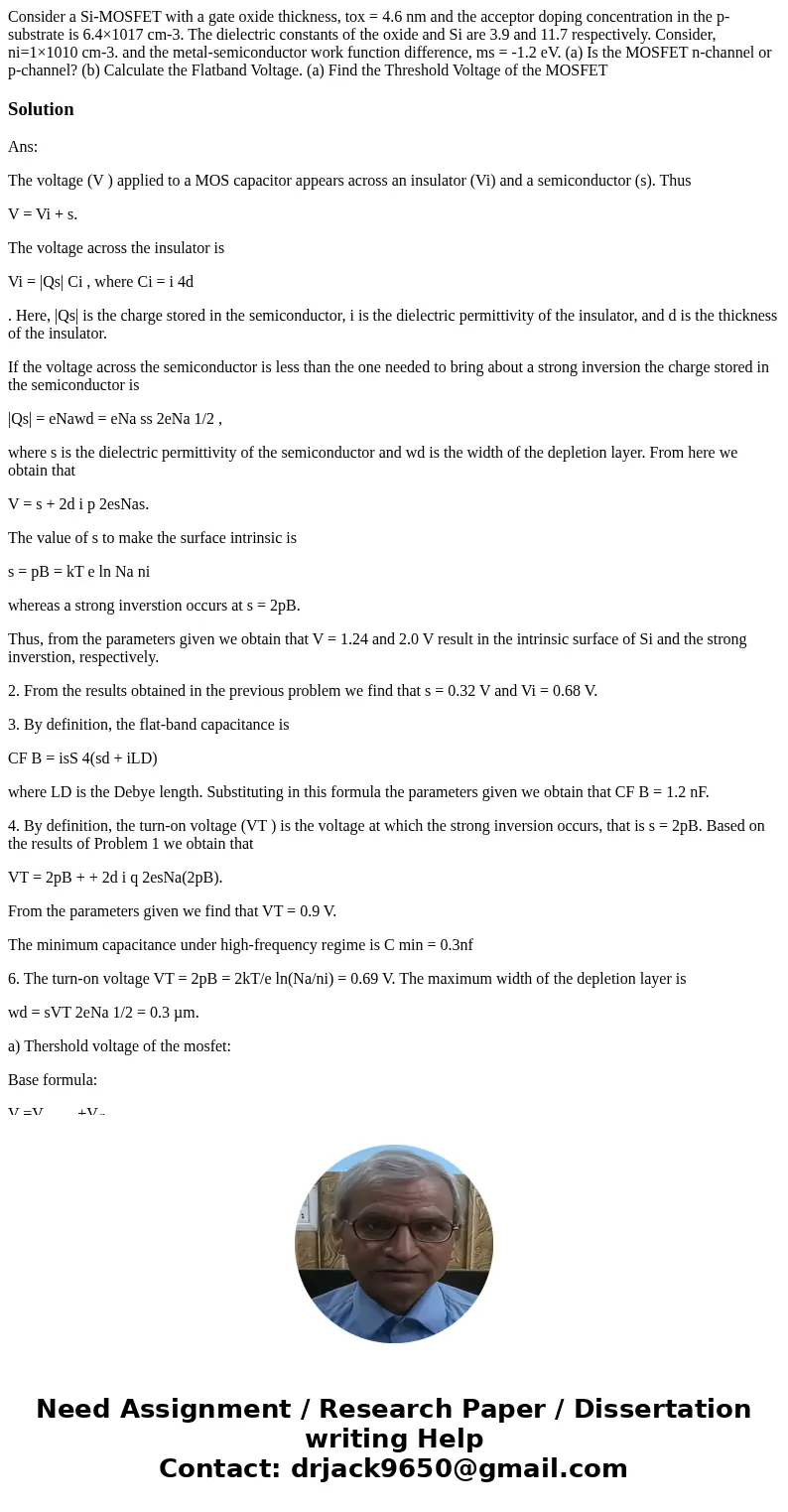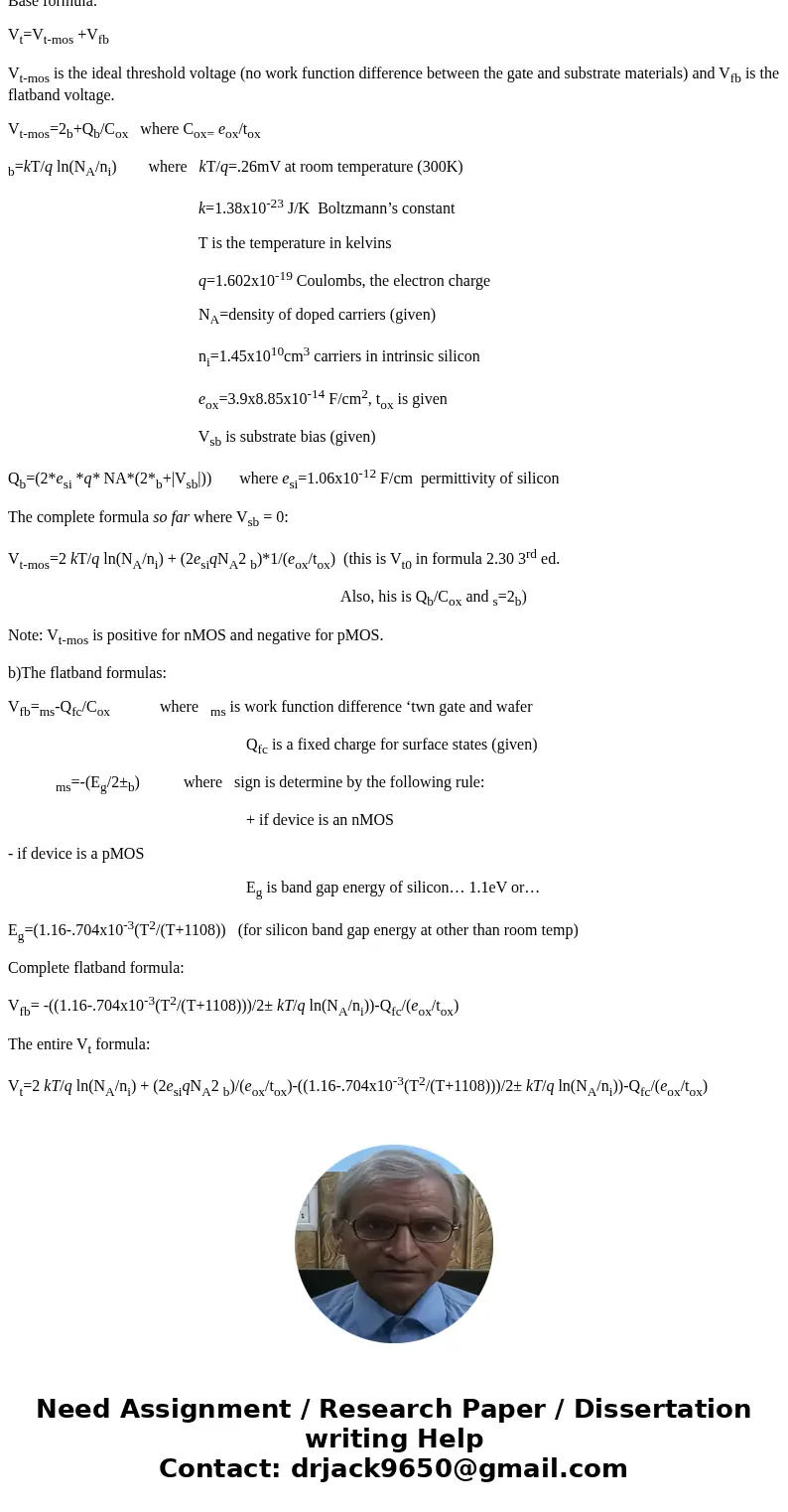Consider a SiMOSFET with a gate oxide thickness tox 46 nm a
Consider a Si-MOSFET with a gate oxide thickness, tox = 4.6 nm and the acceptor doping concentration in the p-substrate is 6.4×1017 cm-3. The dielectric constants of the oxide and Si are 3.9 and 11.7 respectively. Consider, ni=1×1010 cm-3. and the metal-semiconductor work function difference, ms = -1.2 eV. (a) Is the MOSFET n-channel or p-channel? (b) Calculate the Flatband Voltage. (a) Find the Threshold Voltage of the MOSFET
Solution
Ans:
The voltage (V ) applied to a MOS capacitor appears across an insulator (Vi) and a semiconductor (s). Thus
V = Vi + s.
The voltage across the insulator is
Vi = |Qs| Ci , where Ci = i 4d
. Here, |Qs| is the charge stored in the semiconductor, i is the dielectric permittivity of the insulator, and d is the thickness of the insulator.
If the voltage across the semiconductor is less than the one needed to bring about a strong inversion the charge stored in the semiconductor is
|Qs| = eNawd = eNa ss 2eNa 1/2 ,
where s is the dielectric permittivity of the semiconductor and wd is the width of the depletion layer. From here we obtain that
V = s + 2d i p 2esNas.
The value of s to make the surface intrinsic is
s = pB = kT e ln Na ni
whereas a strong inverstion occurs at s = 2pB.
Thus, from the parameters given we obtain that V = 1.24 and 2.0 V result in the intrinsic surface of Si and the strong inverstion, respectively.
2. From the results obtained in the previous problem we find that s = 0.32 V and Vi = 0.68 V.
3. By definition, the flat-band capacitance is
CF B = isS 4(sd + iLD)
where LD is the Debye length. Substituting in this formula the parameters given we obtain that CF B = 1.2 nF.
4. By definition, the turn-on voltage (VT ) is the voltage at which the strong inversion occurs, that is s = 2pB. Based on the results of Problem 1 we obtain that
VT = 2pB + + 2d i q 2esNa(2pB).
From the parameters given we find that VT = 0.9 V.
The minimum capacitance under high-frequency regime is C min = 0.3nf
6. The turn-on voltage VT = 2pB = 2kT/e ln(Na/ni) = 0.69 V. The maximum width of the depletion layer is
wd = sVT 2eNa 1/2 = 0.3 µm.
a) Thershold voltage of the mosfet:
Base formula:
Vt=Vt-mos +Vfb
Vt-mos is the ideal threshold voltage (no work function difference between the gate and substrate materials) and Vfb is the flatband voltage.
Vt-mos=2b+Qb/Cox where Cox= eox/tox
b=kT/q ln(NA/ni) where kT/q=.26mV at room temperature (300K)
k=1.38x10-23 J/K Boltzmann’s constant
T is the temperature in kelvins
q=1.602x10-19 Coulombs, the electron charge
NA=density of doped carriers (given)
ni=1.45x1010cm3 carriers in intrinsic silicon
eox=3.9x8.85x10-14 F/cm2, tox is given
Vsb is substrate bias (given)
Qb=(2*esi *q* NA*(2*b+|Vsb|)) where esi=1.06x10-12 F/cm permittivity of silicon
The complete formula so far where Vsb = 0:
Vt-mos=2 kT/q ln(NA/ni) + (2esiqNA2 b)*1/(eox/tox) (this is Vt0 in formula 2.30 3rd ed.
Also, his is Qb/Cox and s=2b)
Note: Vt-mos is positive for nMOS and negative for pMOS.
b)The flatband formulas:
Vfb=ms-Qfc/Cox where ms is work function difference ‘twn gate and wafer
Qfc is a fixed charge for surface states (given)
ms=-(Eg/2±b) where sign is determine by the following rule:
+ if device is an nMOS
- if device is a pMOS
Eg is band gap energy of silicon… 1.1eV or…
Eg=(1.16-.704x10-3(T2/(T+1108)) (for silicon band gap energy at other than room temp)
Complete flatband formula:
Vfb= -((1.16-.704x10-3(T2/(T+1108)))/2± kT/q ln(NA/ni))-Qfc/(eox/tox)
The entire Vt formula:
Vt=2 kT/q ln(NA/ni) + (2esiqNA2 b)/(eox/tox)-((1.16-.704x10-3(T2/(T+1108)))/2± kT/q ln(NA/ni))-Qfc/(eox/tox)


 Homework Sourse
Homework Sourse